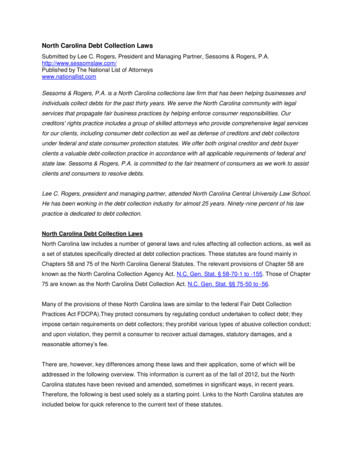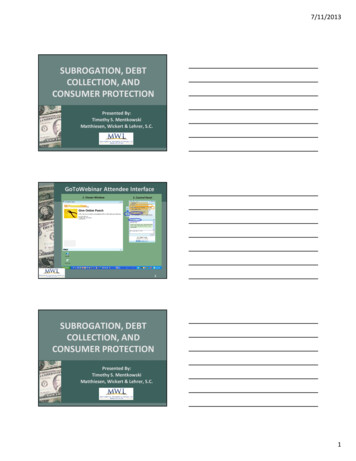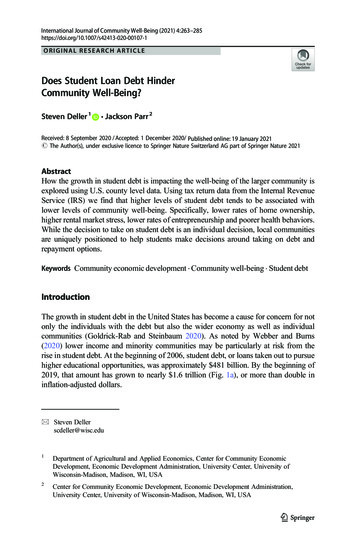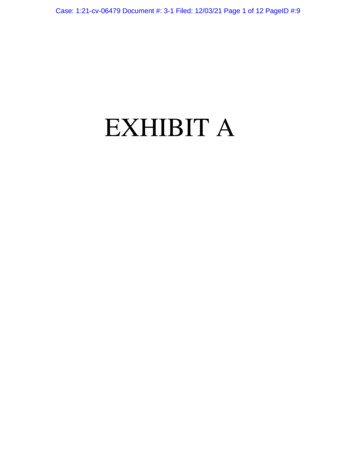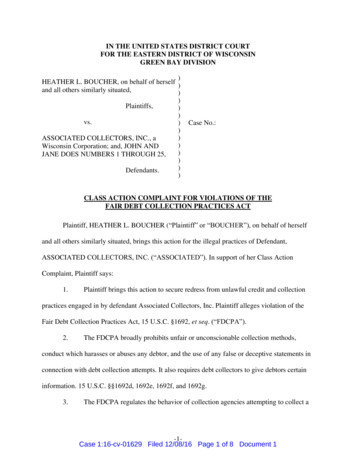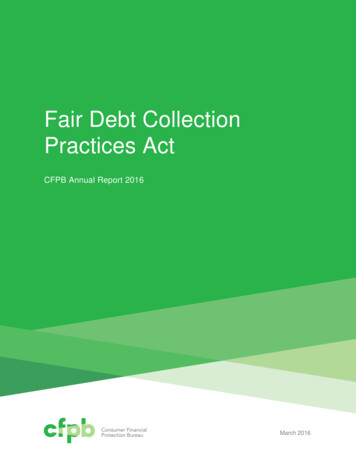
Transcription
Fair Debt CollectionPractices ActCFPB Annual Report 2016March 2016
Message fromRichard CordrayDirector of the CFPBThe Consumer Financial Protection Bureau (“Bureau” or “CFPB”) is the only federal governmentagency dedicated solely to consumer financial protection. Unlawful debt collection practices cancause harm to consumers across virtually all the consumer financial markets we oversee.At the CFPB, we envision a debt collection market that is fair, transparent, and law-abiding. Webelieve the best way to achieve such a market is to ensure that debt collectors have sufficientinformation to support the debt before attempting to collect it, accurately verify that they areattempting to collect from the right consumer if the consumer disputes the debt, andcommunicate with the consumer about the debt in a respectful, honest, and consumer-orientedmanner. We believe such a market is in the best interests of consumers, creditors, and debtcollectors alike.This report describes the federal government’s efforts to administer the Fair Debt CollectionPractices Act (“FDCPA”) in 2015. Among different developments related to debt collection in thepast year, five are particularly noteworthy.First, since its inception, the CFPB has taken enforcement actions to protect consumers fromthese harmful practices. In 2015 such actions by the CFPB returned 360 million to consumerswronged by unlawful debt collection practices and collected over 79 million in fines. Duringthis time period, our colleagues at the Federal Trade Commission (FTC) banned 30 companiesand individuals that engaged in serious and repeated violations of the law from ever againworking in debt collection. In addition, the FTC filed 12 new cases, a record number of debtcollection enforcement actions for the FTC in a year.2
The Bureau finds three of its recent cases to be particularly noteworthy. In its case with JPMorgan Chase, the Bureau took action against the bank for selling credit card debts which, insome cases, overstated the amount owed or misidentified the individual owing the debt. In itscases with Encore and Portfolio Recovery Associates, the nation’s two largest debt buyers, theBureau took action against those entities for demanding payments and filing lawsuits on debtsthat they knew very little about and without reviewing the appropriate documentation to makesure they were collecting the right amount from the right consumer. These matters put over 110 million back in consumers’ pockets, penalized the companies 48 million, and also broughtdebt relief with a face value of several billion dollars to hundreds of thousands of consumers.Taken together, these cases paint a broader picture about how the Consumer Bureau is workingto clean up the market from both ends. Regardless of whether you are a debt seller or a debtbuyer, all players in the collections market need to do their part and invest the resources toensure they are collecting the right amount from the right consumer.Second, the Bureau continues its effort to develop the first comprehensive federal regulationscovering debt collection. We are considering provisions to ensure that debt collectors havesufficient information to collect the debt, prevent unfair, deceptive and abusive acts andpractices, inform consumers of their rights, and provide interpretation of some sections of theFDCPA. In order to inform rulemaking efforts, the Bureau surveyed consumers in 2015 abouttheir debt collection experiences and preferences. Furthermore, the Bureau conducted extensiveinterviews with industry vendors and participants to expand its understanding of the debtcollection market. Currently, the Bureau is preparing to convene one or more Small BusinessRegulatory Enforcement Fairness Act panels before issuing a notice of proposed rulemaking.Additionally, the Bureau continuously engages industry and consumers through roundtables,meetings, and field hearings.Third, the Bureau now has two full years of data on debt collection complaints. In 2015, theBureau handled over 85,200 debt collection complaints, making debt collection the largestsource of consumer complaints. The Bureau forwarded almost half of these complaints to debtcollectors, which responded in a timely manner to 90% of them. The leading reason forcomplaints is consumers being contacted for debts they report they do not owe.Fourth, the Bureau’s examiners completed examinations of debt collection agencies. Theyidentified many violations of the FDCPA, including: misleading statements about creditreporting; failures of debt collectors to identify themselves as debt collectors during calls toconsumers; and failures to ensure that consumer requests about communications, such asrequests not to call at work, were honored. Bureau examiners directed institutions found in3
violation to comply with the FDCPA and in some cases directed them to improve employeetraining, or take other steps necessary to fully comply with the law.Fifth, the CFPB worked closely with the FTC and state regulators to enforce the laws applicableto debt collectors, file amicus briefs, supervise debt collectors, coordinate rulemaking activities,and reach out to consumer and trade groups. The FTC has been a highly valued partner in theCFPB’s efforts to regulate the debt collection industry and enforce the FDCPA. For instance, theFTC led an effort, working with the CFPB and state regulators, to bring over 115 actions againstdebt collection firms and phantom debt scammers. Furthermore, the Bureau and the FTC jointlyfiled two amicus briefs in 2015. Additionally, the CFPB and the FTC organized and participatedin events across the country to engage industry. The CFPB looks forward to continuing andstrengthening its relationship with the FTC, state attorneys general, state regulators, and otherpartners in the mission of protecting consumers from harmful debt collection practices.At the Consumer Bureau, we are committed to protecting consumers and enforcing the law.Through our supervisory, legal, and regulatory efforts we hope to bring about positive changesin the debt collection industry. We intend to establish and enforce clear rules that will do justthat.Sincerely,Richard Cordray4
Table of contentsMessage from Richard Cordray . 2Table of contents. 51. Introduction . 72. Background . 83. Consumer complaints . 163.1 Number and types of complaints received . 183.2 Responses to complaints received . 214. Bureau supervision of debt collection activities . 234.1 Failure to state that a call is from a debt collector . 244.2 Failure to implement consumer requests regarding communications . 244.3 False, deceptive or misleading representations regarding creditreporting . 255. Enforcement . 275.1 Bureau law enforcement actions . 285.2 FTC law enforcement actions . 385.3 Debt collection advocacy . 506. Education and outreach initiatives . 555
6.1 Bureau education and outreach initiatives . 556.2 FTC education and public outreach . 597. Rulemaking, research, and policy initiatives . 617.1Bureau rulemaking and research . 617.2 FTC’s research and policy development activities . 648. Conclusion . 67Appendix:6FTC Letter . 68
1. IntroductionThe Consumer Financial Protection Bureau (“CFPB” or “the Bureau”) is pleased to submit toCongress its fifth annual report summarizing activities to administer the Fair Debt CollectionPractices Act (“FDCPA”), 15 U.S.C. § 1692 et seq. The Bureau and the Federal Trade Commission(“FTC” or “the Commission”) share overall enforcement responsibility for the FDCPA. TheCommission’s activities during the past year are included in this report as the Appendix. TheCFPB and the FTC work closely to coordinate debt collection enforcement actions among othermatters related to debt collection.1This report (1) provides a background of the debt collection market; (2) contains an overview ofconsumer complaints submitted to the CFPB and the FTC in 2015; (3) summarizes the Bureau’ssupervisory activities in the debt collection market; (4) describes the Bureau’s and theCommission’s enforcement actions; (5) presents the CFPB’s and FTC’s consumer education andoutreach initiatives; and (6) discusses developments in the Bureau’s rulemaking activities, andthe FTC’s policy and research initiatives.17See Memorandum of Understanding between the Consumer Financial Protection Bureau and the Federal TradeCommission (March 2015), available ration agreements/150312ftc-cfpb-mou.pdf. As part of thiscoordination, CFPB and FTC staff regularly meet to discuss ongoing and upcoming law enforcement, rulemaking,and other activities, share debt collection complaints, cooperate on consumer education efforts in the debtcollection arena, and consult on debt collection rulemaking and guidance initiatives.
2. BackgroundDebt collection is a 13.7 billion dollar industry that employs more than 130,000 people2 acrossapproximately 6,000 collection agencies.3 The debt collection industry affects millions ofAmericans. A research project by the Urban Institute examining credit reports showed that 35%of Americans, more than 77 million people, had a trade line on their credit reports indicatingsome type of debt in collections – including financial, healthcare, retail, and telecom debt.4These debts averaged 5,178, ranging from as little as 25 to as much as 125,000. A substantialportion of this debt is likely being collected by third-party collection agencies. Many consumersare not aware that they have debts in collections until they receive calls from debt collectors orreview their credit reports.5Industry breakdownDebt collectors generate most of their revenue from collections of medical debt, student loans,and financial services obligations such as credit cards, auto loans, and mortgages. Financialservices are the largest source of revenue for the industry, accounting for more than a third of alldebt collection revenue. However, telecommunications debt also accounts for a large share of2Edward Rivera at IBIS World, Debt Collection Agencies in the US (September 2015).3This figure was obtained with an Infogroup Government Division search for businesses with the debt collectionNAICS code.4Caroline Ratcliffe et al. “Delinquent Debt in America.” Urban Institute. July 2014. available uent-debt-america.5Consumer Financial Protection Bureau, CFPB Considers Debt Collection Rules (2013), available siders-debt-collection-rules.8
industry revenue – more than a fifth.6 Government, retail, and medical debt also comprisesignificant amounts of the market’s revenue.FIGURE 1: DEBT COLLECTION MARKET SEGMENTS BY SHARE OF REVENUE, 2015 (IBIS WORLD)Financial servicesTelecommunicationsOtherHealthcareRetail and commercialGovernment0%5%10%15%20%25%30%35%40%More than half the industry’s revenue, 7.5 billion, is generated by firms contracting withcreditors to collect their debts on a contingency fee basis – in contingency fee collections, thecreditor and the collector each receive a share of the amount collected. About one third of debtcollection revenue, 4.4 billion, comes from debt buyers, who purchase accounts from theoriginal creditor or other debt buyers and then generally seek to collect on that debt, eitherthemselves or through third-party debt collectors.76Edward Rivera at IBIS World, Debt Collection Agencies in the US (September 2015).7Edward Rivera at IBIS World, Debt Collection Agencies in the US (September 2015).9
FIGURE 2 DEBT COLLECTION AGENCY TYPES BY SHARE OF REVENUE, 2015 (IBIS WORLD)Since the early 1990s, debt buying has become a substantial part of the collections process.8Banks and other credit card issuers often sell defaulted credit card debt, which debt buyerseither collect in-house or place with other collection agencies. Debt buyers may also repackagepurchased debt portfolios and sell them to other buyers. The two biggest debt buyers arepublicly traded companies; combined, they earned more than 2.1 billion in gross annualrevenues in 2015.9The sale and resale of debts has raised concerns about data integrity and information flows fromcreditor to debt buyer to subsequent debt buyers and potentially also to one or many debtcollectors along the way. Recent Bureau enforcement activities discovered examples of how8Federal Trade Commission, The Structure and Practices of the Debt Buying Industry (January 2013), available ry/debtbuyingreport.pdf.9SEC Filings, 10-K (2015). Encore Capital Group and PRA Group.10
consumers are harmed by the ineffective flow of information through the collections lifecycle.10In 2014, the Office of the Comptroller of Currency (“OCC”) issued a bulletin providing guidanceto national banks and federal savings associations engaged in debt sales.11 The OCC issuedsupervisory expectations for information exchange, categories of debt that should not be sold,and due diligence practices for debt buyers, among other measures for the application ofconsumer protection requirements and safe and sound banking. After this bulletin, the Bureauwas advised through market outreach that many banks have eliminated or restricted the abilityof debt buyers to resell purchased customer debt. Some creditors have gone further andcompletely halted debt sales. Many small and medium-sized firms have exited credit card debtbuying or have been acquired by larger debt buyers.12These and other changes have produced significant market consolidation in recent years.According to a study by the Association of Credit and Collection Professionals, there were 25%fewer debt collection agencies in 2013 than in 2005,13 despite industry revenues being slightlyhigher.14Market OutlookIn coming years, the supply of debt is expected to increase across debt markets. Consumer creditis expanding, and the collections industry is projecting continued growth for the next fiveyears.15 Consumer credit excluding mortgages is 615 billion higher than pre-2008 levels. While10See e of the Comptroller of the Currency, Risk Management Guidance (August 2013), available /bulletin-2014-37.html.12According to Kaulkin Ginsberg, M&A activity has increased by more than 70% between 2012 and 2014 available -in-2015.13ACA International, Ernst and Young, Impact of Third-Party Debt Collection on the National and State Economies(2014, 2012, 2011, 2007), available at x.14Edward Rivera at IBIS World, Debt Collection Agencies in the US (September 2015).15Edward Rivera at IBIS World, Debt Collection Agencies in the US (September 2015).11
revolving debt continues to grow, non-revolving debt, driven largely by student loans, is growingeven faster and is now almost 60% higher than pre-recession levels.16Against a backdrop of overall growth, the market is changing in significant ways. In the lastdecade, the student loan market has undergone rapid growth and change. 17 Student debt is nowthe largest category of unsecured debt owed by American consumers. Today, the CFPB estimatesthat there are over 40 million borrowers with student loans who collectively owe over 1.2trillion.18 We estimate that there are nearly 8 million student loan borrowers in default,representing over 110 billion in balances.19 The overall volume of student loans in default hasgrown at a rapid rate, and outstanding student loan debt20 continues on an upward trajectory; 21some sources suggest that outstanding student loan debt grew nearly 25% from 2012 to 2015.22On the other hand, the number of Americans with medical debts in collections may be on thedecline. One study states that the number of Americans reporting medical bill problemsdeclined in 2014, the first time since 2005. The number of Americans between 19 to 64 years ofage reporting that they were contacted by a collection agency about medical bills declined from16Board of Governors of the Federal Reserve, Consumer Credit – G.19 (January 2016), available nt.17Consumer Financial Protection Bureau, Student Loan Servicing (September 2015), available athttp://files.consumerfinance.gov/f/201509 cfpb student-loan-servicing-report.pdf.18Consumer Financial Protection Bureau, Request for Information Regarding Student Loan Servicing (May 2015),available at http://files.consumerfinance.gov/f/201505 cfpb-rfi-student-loan-servicing.pdf.19Id.20US Department of Education, Federal Student Aid Data Center (March 2015), available athttps://studentaid.ed.gov/data-center.21Federal Reserve Bank of New York, Student Loan Debt by Age Group (March 2013), available html.22Board of Governors of the Federal Reserve, Consumer Credit G.19 (November 2015), available nt.12
41 million in 2012 to 37 million in 2014, perhaps as a result of recent growth in health insurancecoverage.23FIGURE 4 GROWTH IN NONREVOLVING AND STUDENT LOAN DEBT SINCE 2010 (FEDERAL RESERVE)Growth in lending through auto loans and bank-issued credit cards may also increase the overallamount of Americans’ indebtedness. Even with low default rates, the rising number of consumercredit accounts may increase placements by creditors to collection agencies and boost thenumber of debt sales. The growth of subprime lending in auto, which recently reached a post-23The Commonwealth Fund, Biennial Health Insurance Survey (January 2015), available athttp://www.commonwealthfund.org/ /media/files/publications/issuebrief/2015/jan/1800 collins biennial survey brief.pdf?la en.13
recession high (light green in Figure 5 below),24 and subprime bank-issued credit cards (42.9%more in 2014 compared to 2013) will also contribute to growth in the debt collection industry.25FIGURE 5 AUTO LOAN ORIGINATION VOLUME BY CREDIT TIER (FEDERAL RESERVE)24Federal Reserve Bank of New York. Liberty Street Economics. “Just released: New and Improved Charts and Dataon Auto Loans.” November 19, 2015. available at html#.VrTjO7jR9mM.25Equifax, Equifax Reports New Credit Growth for Bank- and Retail-Issued Cards Led by Subprime Segment(November 2014), available at aseID 881777.14
While debts continue to rise across many sectors, implying significant growth in accounts incollections, the industry also faces challenges adjusting to a new regulatory and legalenvironment. The CFPB and FTC have taken actions, detailed throughout this report, to enforcedebt collection laws – primarily the FDCPA. Consumer litigation against debt collectors has alsoincreased significantly in recent years. Litigation under the FDCPA increased significantly sincethe start of the recession from 4,316 cases in 2007 to 11,697 in 2015. Litigation under the FairCredit Reporting Act has also increased rapidly from 1,515 cases in 2007 to nearly 3,751 cases in2015. 26FIGURE 6 CONSUMER LITIGATION IN THE DEBT COLLECTION MARKET (WEBRECON)26WebRecon. “Out Like a Lion Debt Collection Litigation & CFPB Complaint Statistics, Dec 2015 & Year inReview.” (December 2015).15
3. Consumer complaintsCollecting, investigating, and responding to consumer complaints are integral parts of theCFPB’s work.27 The CFPB’s Office of Consumer Response (“Consumer Response”) hearsdirectly from consumers about the challenges they face in the marketplace, brings theirconcerns to the attention of companies, and assists in addressing these complaints.The CFPB, which began taking consumer complaints about debt collection in July 2013,accepts complaints through its website and by telephone, mail, email, fax, and referral.Consumers submit complaints on the Bureau’s website using complaint forms tailored tospecific products, and can also log on to a secure consumer portal to check the status o f acomplaint and review a company’s response. When completing the complaint form,consumers provide a narrative of the events giving rise to their complaint and—beginningin 2015–can elect to publish a scrubbed narrative on the Bureau’s website. While on thewebsite, consumers can chat with a live agent to get help completing a complaint form.Consumers can also call the Bureau’s toll-free number to ask questions, submit a complaint,check the status of a complaint, and more. 28 The Bureau answers questions and refersconsumers to other regulators or additional resources as appropriate and forwardscomplaints to companies for review and response.27See Dodd-Frank Wall Street Reform and Consumer Protection Act, Pub. L. No. 111-203, § 1021(c)(2) (2010).(“Dodd-Frank Act”).28The CFPB’s U.S.-based contact centers provide services to consumers in more than 180 languages and toconsumers who are deaf, have hearing loss, or have speech disabilities via a toll-free telephone number.16
The CFPB’s complaint handling process focuses on collecting, investigating, and responding tocomplaints.29 The Bureau also uses complaints for law enforcement purposes and sharescomplaint data with the FTC. Using the Bureau’s information, as well as complaints submitteddirectly to it by consumers and from other federal and state agencies, the FTC compilesconsumer complaints in its Consumer Sentinel system and makes them available to federal andstate law enforcement. The FTC uses consumer complaints generally to monitor the debtcollection industry, select targets for investigation, and conduct preliminary analysis that, withfurther factual development, might reveal or help prove a law violation.As in previous years, collections is the most complained about product in the Bureau’scomplaint system. As shown in Table 1, in 2015, again the most common issue selected byconsumers submitting a debt collection complaint is continued attempts to collect a debt thatthe consumer states is not owed (40%). Many consumers, for example, report that they alreadypaid the debt in collection. In many of these complaints, the attempt to collect the debt is notitself the problem; rather, consumers assert that the calculation of the amount of underlyingdebt is inaccurate or unjust. In other complaints, the consumer complains about the furnishingof information to credit reporting agencies.Though consumers selected communication tactics as their primary issue at a lower rate than in2014 (see Table 2), complaints about debt collectors’ communications tactics (telephone callsespecially) continue to be common (18%). In addition to complaints about collection calls thatare too frequent or at inconvenient times of the day, there are a significant number ofcomplaints about calls to third-parties or calls to the consumer’s place of employment.Consumers continue to submit complaints about a lack of debt verification by collectors inresponse to consumer disputes; in fact, this issue saw the largest percentage increase from 2014(see Table 2). Consumers are often asking for debt collectors to provide more detaileddocumentation of the debt that is being collected. The lack of documentation provided by somedebt collectors appears to frustrate consumers, especially when the documentation is a simpleinvoice or bill for the services or goods that were the subject of the debt being collected. Thereare a number of collectors that respond to consumer complaints about the lack of verificationthey have been provided by ceasing collection and returning debts to creditors.2917See Dodd-Frank Act, Pub. L. No. 111-203, § 1021(c)(2), 124 Stat. 1376, 1979 (2010).
3.1Number and types of complaintsreceivedFrom January 1, 2015 through December 31, 2015, the CFPB handled approximately 85,200debt collection complaints—3,100 fewer complaints than the prior year, although still the mostcommon of all the products the Bureau handles. These complaints include first-party (creditorscollecting on their own debts) and third-party collections. Table 1 shows the types of debtcollection complaints the CFPB has received, while Table 2 shows the change in complaintvolume by issue.30TABLE 1:30DEBT COLLECTION COMPLAINTS BY ISSUEPrimary issue%Continued attempts to collect debt not owed40%Communication tactics18%Disclosure verification of debt15%Taking or threatening an illegal action11%False statements or representation9%Improper contact or sharing of information7%Total debt collection complaints100%The Bureau recognizes that, for a variety of reasons, the debt collection complaints it receives may understate oroverstate the extent of debt collector law violations: http://www.consumerfinance.gov/f/201307 cfpb debtcollection-letter 1-not-my-debt.doc.18
TABLE 2:CHANGE IN COMPLAINT VOLUME BY ISSUEFor each of the six issues listed in Table 1 and Table 2, consumers also select additional, moredetailed sub-issues when submitting a complaint.As indicated in Table 1, the most common debt collection complaint is about continued attemptsto collect a debt that the consumer reports is not owed. The vast majority of these consumersreport that the debt is not their debt (63%) or that the debt was paid (26%), while the remainingconsumers report that the debt resulted from identity theft (6%) or was discharged inbankruptcy (4%).Complaints about communication tactics used when collecting debts are the second-mostcommon issue selected by consumers (see line 2 in Table 1). Many of these types of complaintsare about improper telephone calls. The majority of complaints about communication tactics areabout frequent or repeated calls (52%). Often, these complaints stem from being called aboutanother person’s debt. Sometimes the call is for someone with a similar name. More often, itappears the call recipient’s phone number has mistakenly been included in the collector’sinformation about the alleged debtor’s account. Consumers often complain to the CFPB whenthe collector continues to call even after the consumer has repeatedly told the collector that thealleged debtor cannot be contacted at the dialed number. They also complain about debtcollectors calling their places of employment or third parties. Other communication tacticscomplaints relate to reports of companies threatening to take legal action (31%), using obscene,profane, or abusive language (8%), calling after being sent written cease communication notices(6%), or calling outside of the FDCPA’s assumed convenient calling hours from 8 a.m. to 9 p.m.at the consumer’s location (3%).Complaints involving consumers’ disputes about debts were common in 2015 (see line 3 of Table1). If a debt collector does not include the information in its initial communication with the19
alleged debtor, the FDCPA requires collectors within five days of that communication to provideconsumers with a written notice informing them, among other things, of their right to disputedebts. Some consumers, however, complain that debt collectors do not provide a notice withinfive days of the collectors’ initial communication to collect (28%). Most consumers whocomplain about the dispute process raise the concern that when they exercise their rights todispute debts, collectors do not provide them with documentation that consumers believecollectors need to verify the debt (64%). The complaints related to disputed debts also revealconfusion on the part of consumers as to when and how they can dispute a debt.31 Otherconsumers report that the company did not disclose that the communication was an attempt tocollect a debt (8%).Consumers also commonly report that the company is taking or threatening to take an illegalaction (see line 4 of Table 1). Most of these complaints are about threats to arrest or jailconsumers if they do not pay (47%). Other complaints relate to lawsuits including threats to sueon a debt that is too old (28%), being sued without proper notification of the lawsuit (9%),seizures or attempts to seize property (7%), collection or attempts to collect exempt funds suchas child
Third, the Bureau now has two full years of data on debt collection complaints. In 2015, the Bureau handled over 85,200 debt collection complaints, making debt collection the largest source of consumer complaints. The Bureau forwarded almost half of these complaints to debt collectors, which responded in a timely manner to 90% of them.


